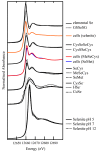Selenium metabolism in cancer cells: the combined application of XAS and XFM techniques to the problem of selenium speciation in biological systems
- PMID: 23698165
- PMCID: PMC3708347
- DOI: 10.3390/nu5051734
Selenium metabolism in cancer cells: the combined application of XAS and XFM techniques to the problem of selenium speciation in biological systems
Abstract
Determining the speciation of selenium in vivo is crucial to understanding the biological activity of this essential element, which is a popular dietary supplement due to its anti-cancer properties. Hyphenated techniques that combine separation and detection methods are traditionally and effectively used in selenium speciation analysis, but require extensive sample preparation that may affect speciation. Synchrotron-based X-ray absorption and fluorescence techniques offer an alternative approach to selenium speciation analysis that requires minimal sample preparation. We present a brief summary of some key HPLC-ICP-MS and ESI-MS/MS studies of the speciation of selenium in cells and rat tissues. We review the results of a top-down approach to selenium speciation in human lung cancer cells that aims to link the speciation and distribution of selenium to its biological activity using a combination of X-ray absorption spectroscopy (XAS) and X-ray fluorescence microscopy (XFM). The results of this approach highlight the distinct fates of selenomethionine, methylselenocysteine and selenite in terms of their speciation and distribution within cells: organic selenium metabolites were widely distributed throughout the cells, whereas inorganic selenium metabolites were compartmentalized and associated with copper. New data from the XFM mapping of electrophoretically-separated cell lysates show the distribution of selenium in the proteins of selenomethionine-treated cells. Future applications of this top-down approach are discussed.
Figures





References
-
- Clark L.C., Combs G.F., Turnbull B.W., Slate E.H., Chalker D.K., Chow J., Davis L.S., Glover R.A., Graham G.F., Gross E.G., et al. Effects of selenium supplementation for cancer prevention in patients with carcinoma of the skin. A randomized controlled trial. JAMA. 1996;276:1957–1963. doi: 10.1001/jama.1996.03540240035027. - DOI - PubMed
Publication types
MeSH terms
Substances
LinkOut - more resources
Full Text Sources
Other Literature Sources

